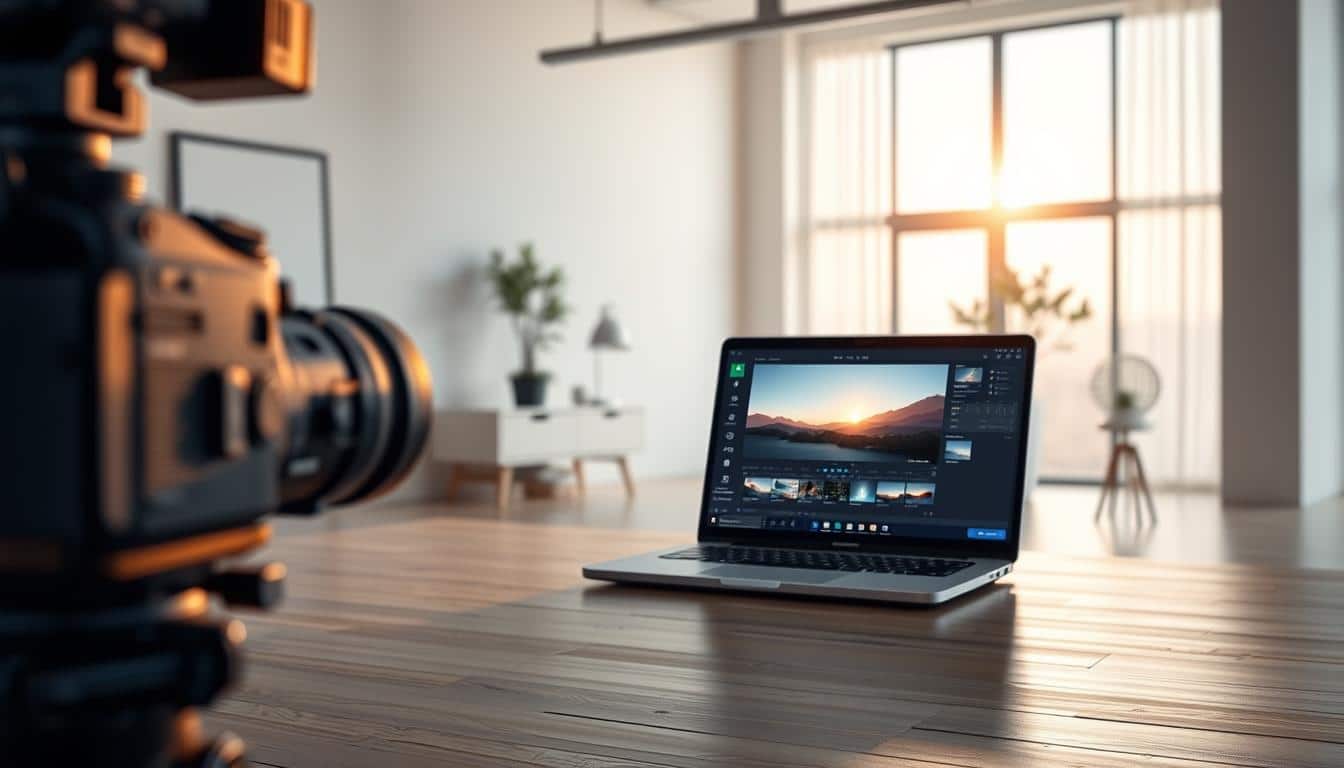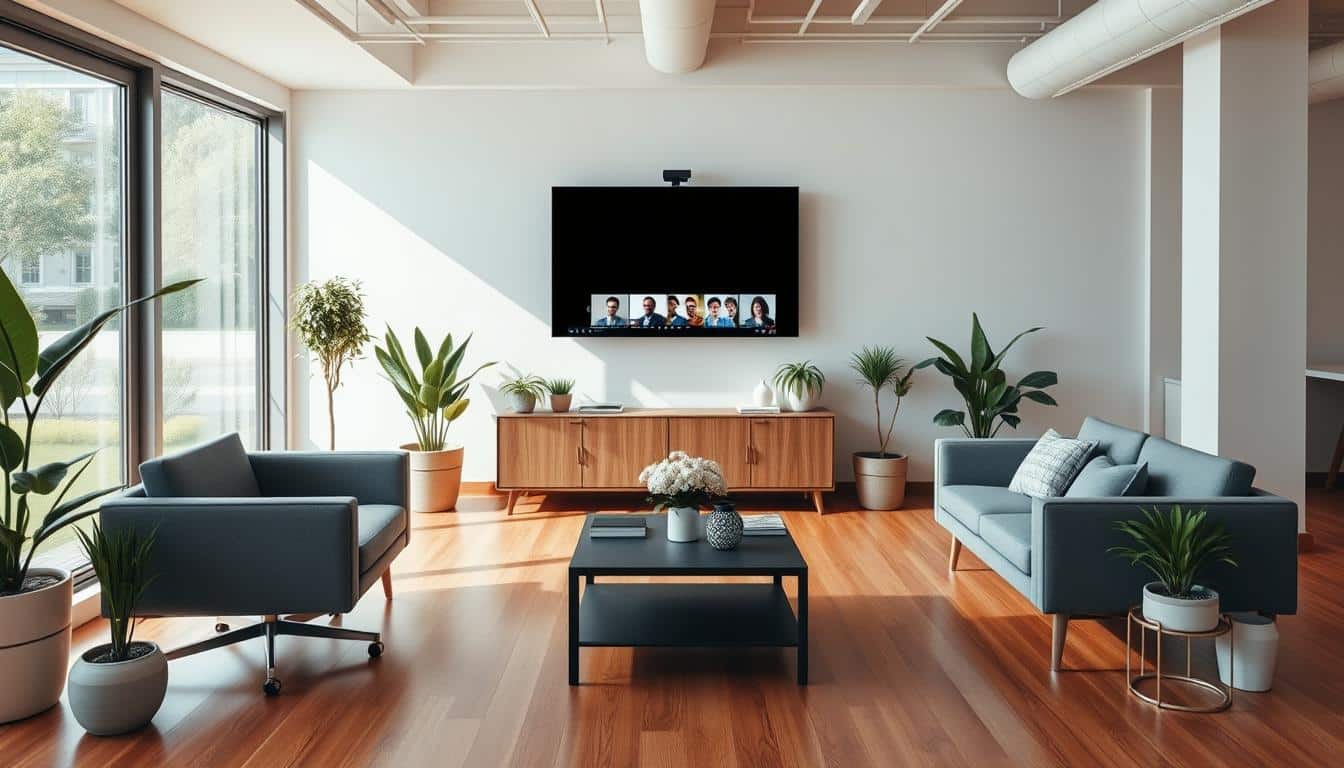Anúncios
Video calls are now a big part of our lives. Virtual backgrounds have become popular. This guide shows how to make your video calls look better and keep your privacy. You can use tools like Adobe Photoshop, Canva, and Zoom to make your background. This tells you how to show your style or brand.
Good camera quality and lighting make video calls much better. This guide gives tips and steps for the best virtual background. Let’s learn about making your online meetings look great in 2023.
Anúncios
Understanding Virtual Backgrounds
Virtual backgrounds are digital images that change the real backdrop seen in video calls. They are used a lot in work settings to keep things private and set the right mood. These backgrounds get rid of distractions. This lets people pay attention to their talks and shows without messy real-life scenes getting in the way.
Definition and Purpose
Using virtual backgrounds brings many perks. They make meetings look more professional. Plus, they let you show off a look that fits your brand or message. Picking the right background is key. You need one that makes you pop. Avoid busy or jumbled ones to keep your professional look sharp. Simple backgrounds are usually the best choice.
Anúncios
Benefits for Video Conferencing
- Enhanced focus by removing physical distractions.
- Increased engagement through tailored backgrounds that reflect the occasion.
- Support for branding efforts, maintaining consistency in visual identity across calls.
- Improvement in video quality through careful attention to color, blur settings, and background detail.
- The effect of motion and movement on how virtual backgrounds are perceived, ensuring they remain effective.
With the right virtual backgrounds, you can make your video meetings better and more memorable.
How Virtual Backgrounds Work
Virtual backgrounds use advanced technology for a seamless video call experience. They blend chroma keying and artificial intelligence to work. This combo separates you from your actual surroundings. It smoothly swaps real scenes with digital ones.
Technology Behind Virtual Backgrounds
Chroma keying is key in making virtual backgrounds. It replaces a solid-colored backdrop with a digital image. AI then steps in to refine the user’s appearance. Bright, even light is crucial to this tech’s success. It helps remove shadows for a clearer image. Ideally, use backgrounds that are 1280×720 pixels and in a 16:9 ratio.
Video Background Eraser Software
Video background eraser tools let you tailor your virtual space. With apps like Recraft, using AI, you can change your background easily. You can upload pictures or pick from existing ones. Zoom supports GIFs, JPGs/JPEGs, and PNGs. For high-quality results, use images that are 1920×1080 pixels, up to 5MB in size. Using compression tools, like Squoosh or TinyPNG, helps with fast uploads while keeping the image sharp.
Choosing the Right Video Conferencing Software
Choosing the right video conferencing software is key to good communication and teamwork. There are many options to pick from. It’s crucial to choose ones that have virtual backgrounds and meet your needs. Look for features like easy-to-use interfaces, good video quality, and browser compatibility.
Popular Platforms Offering Virtual Backgrounds
Many top video conferencing tools support virtual backgrounds. Some well-known ones are:
- Zoom: It has an easy-to-use interface. Users can easily pick or upload their own virtual backgrounds.
- Microsoft Teams: Offers built-in virtual backgrounds, perfect for official meetings.
- Google Meet: Lets users choose from preset backgrounds or upload their own, making meetings more engaging.
- ClickMeeting: Can host up to 10,000 participants in its enterprise version and has a modern interface.
Browser Compatibility for Optimal Usage
It’s important to ensure your video conferencing software works well with your browser. Use the newest versions of Chrome, Firefox, Microsoft Edge, or Safari for the best experience. These platforms are made to run smoothly with these browsers. This improves video call quality and minimizes technical issues.
Types of Virtual Backgrounds
Virtual backgrounds come in various types, each with unique features. They meet different needs and preferences. These types include static backgrounds, animated backgrounds, and 3D virtual backgrounds. They help users make their online presence more engaging.
Static and Animated Backgrounds
Static backgrounds give a clean and simple look, perfect for work calls. Users can pick plain walls or neutral shades for a professional vibe. Animated backgrounds, however, add motion and fun to video chats. They let users show off their creativity with custom or professional designs.
3D Virtual Backgrounds
3D virtual backgrounds make video calls feel like real-life meetings. They let people feel they’re in new places, like a café or office. Adding 360-degree views makes it even more real. This advanced feature keeps viewers interested and makes conversations more lively.
Virtual Background Setup Guide
Setting up a virtual background makes your video calls better. We guide you through installing and adjusting settings for software like Zoom and Google Meet. This ensures you look sharp on your calls.
Step-by-Step Installation Process
Follow these steps to add virtual backgrounds on popular platforms:
- Join a meeting on your chosen platform.
- Click the upward arrow by the Video button to access settings.
- Choose “Adjust Background & Effects” or something similar.
- Pick an option:
- None: Removes any background.
- Blur: Blurs your surroundings nicely.
- Default or uploaded media: Use a default background or upload your picture.
- Upload your own: Click the plus (+) icon for your chosen background.
- AI-generated background: Type an idea and click Generate.
Optimal Settings for Different Software
Adjust settings for better virtual background quality. Follow these suggestions:
- Resize your background image to match the platform’s requirements for high quality.
- Test your virtual background in a trial meeting to catch any issues.
- Proper lighting and camera angles enhance the virtual background. Ensure your location is well-lit to avoid shadows.
- If you need more background options, look for free online resources.
Using these tips for setting up and fine-tuning virtual backgrounds will give your video calls a professional edge.
Downloading and Creating Virtual Backgrounds
In the world of online meetings, virtual backgrounds are key. They make your presentation better. Many free resources let you find or make a perfect background that reflects your style or brand.
Free Resources for Backgrounds
Using sites like Livestorm gives you access to over 100 virtual background options. Schools like the University of Oregon provide unique backgrounds too. For great visuals, turn to royalty-free images from Pexels, Unsplash, and Pixabay.
Creating Custom Backgrounds Using Graphic Design Tools
If you want something unique, make your backgrounds with graphic design tools. Tools like Canva and Adobe Spark are easy to use for creating great backgrounds. You can add your photos or videos. Just keep a 16:9 ratio and at least 1280 x 720 pixels for the best look.
Enhancing Your Background Experience
Making your video call background better adds to professionalism and focus. Using blurry backgrounds helps keep the privacy. This smart change cuts down on distractions from home, so people can pay more attention to the conversation.
Using Blurred Backgrounds for Privacy
Blurred backgrounds are great for a neat and focused look. They let you look put-together with no need for fancy setups. Here’s how you can achieve blurry backgrounds effectively:
- Select soft color palettes that emit professionalism, such as light greys and neutrals.
- Ensure minimalistic backgrounds to avoid overwhelming the viewer.
- Test your setup beforehand to mitigate any technical problems during calls.
Best Practices for Adding Animation Effects
Animations can make the background more interesting if used wisely. Small, moving details keep the background lively without distracting from you. Follow these tips to use animation well:
- Choose gentle animations that complement rather than compete with the presenter.
- Avoid busy patterns or fast movements that can distract viewers.
- Incorporate branding elements such as logos or company colors to reinforce your identity.
Face Beautification and Additional Features
Face beautification technology has changed how we show ourselves on video calls. It makes us look polished and confident. Now, video chats have many tools to improve our looks easily.
Understanding Face Touch-Up Technology
Face touch-up tech lets us improve our looks in subtle ways. It offers features like face thinning and making the skin look perfect. This leads to a smoother skin appearance and hides flaws.
It also enhances eyes and makes smiles brighter. With advanced AI, it tracks facial features in real time for the best results.
Benefits for Professional Appearance
Using face beautification can make us look more professional online. It lets us try different looks with customizable effects and virtual makeup. Adding virtual jewelry and glasses boosts our visual impact.
It uses high-quality effects to make interactions look real. This helps us look our best and feel confident in a digital workspace.

Common Issues and Troubleshooting
Users might face challenges with virtual backgrounds that affect how they look online. Solving these problems means fixing internet and picture quality issues. Doing so improves how you appear during video chats.
Connectivity Problems
Having a bad connection can ruin virtual backgrounds. You need a fast and steady internet to avoid issues. If you’re having trouble, try these steps:
- Check your network connection for stability and speed.
- Close all other applications that might be using your camera, such as Skype or FaceTime.
- Restart your device to resolve potential software conflicts.
- Ensure that permissions are granted for the video conferencing software to access your camera.
Always keep the software up to date. Outdated versions can lead to problems with your virtual background.
Image Quality and Resolution Concerns
The way your virtual background looks depends a lot on image quality. Bad lighting or a cheap camera can mess things up. To get better results, follow these tips:
- Utilize a 3-point lighting system to enhance visibility.
- Verify that your webcam meets minimum specifications, including a compatible processor and sufficient RAM.
- Choose high-resolution images (at least 1920×1080 pixels) in appropriate formats like JPEG or PNG.
- Avoid clothing colors that closely match the virtual background to prevent blending issues.
If your custom videos look wrong, make sure they’re in MP4 or MOV format. Good lighting is key to mixing real and virtual backgrounds well. If you’re still stuck, tweak the software’s brightness and contrast settings. Or, try using a background blur instead.
Tips for a Professional Look
To look pro on video calls, pay close attention to lighting, where your camera is, and what’s behind you. A well-set-up video can really make you stand out in a good way. This can impress viewers or future employers.
Lighting and Camera Placement
Good lighting makes your video look better. Use natural and room lights to improve how things look and feel. If you need more light, a ring light can give you even, nice lighting. Here are some key lighting tips:
- Have lights in front of you to keep shadows off your face.
- Put the camera a bit higher than your eyes for a better view.
- Before calls, check your lighting and how you look with a mirror.
Camera placement is all about focusing on you without any distractions. Putting your camera in the right spot helps people pay more attention during chats.
Choosing Appropriate Backgrounds for Different Situations
Picking the right background matters a lot. Studies show 97% of recruiters like a simple background. They think it’s important to keep things neat. Here’s how to pick backgrounds:
- Add things like plants or art to make it interesting but not messy.
- Keep your background the same for all interviews to show you’re prepared.
- If your real background isn’t great, try a virtual one that looks nice on you.
- Stay away from messy or moving things like fans in your background.
Real-Life Use Cases for Virtual Backgrounds
Virtual backgrounds open doors to exciting experiences in both work and fun chats. They let us change our scenery with just a click, making talks more interesting. Whether it’s for a business call or hanging out online, these backgrounds make every meeting special.
Business Meetings and Webinars
Choosing the right virtual background is key in business scenes. A library scene can spark interest and keep everyone focused. Simple home settings show you’re serious, and office looks give off a pro vibe.
For a creative touch, use artsy or museum-like scenes to dazzle. Adding your logo during virtual events keeps your brand in the spotlight. It’s all about creating the right image and vibe.
Casual Calls with Friends and Family
For fun chats, try backgrounds that bring smiles. Imagine talking in a scene from your favorite show or amidst seasonal beauty. It makes every call a bit more magical.
Kitchen scenes are perfect for online cook-offs or dinner parties. These choices let you express yourself and make memories, even online. It’s all about adding joy to our conversations.
Conclusion
Virtual backgrounds greatly improve video conferencing. They make meetings look more professional and interesting. By customizing their background, people can grab their audience’s attention whether it’s a formal or informal gathering.
Virtual backgrounds add value to video content, making it more captivating. By choosing the right background and setting it up properly, users make a strong impression. This ensures their virtual presence is both impactful and professional.
Exploring different backgrounds, like images or animated GIFs, is key to personalizing meetings. Making sure your system meets the needs for these backgrounds is important. Solving any problems quickly ensures a smooth experience. Virtual backgrounds can truly change your online interactions, making them more engaging.



